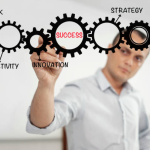Introduction to Product Development
Defining Product Development
Product development is a complex, multidisciplinary process that involves the transformation of a market opportunity into a product available for sale. It’s the complete lifecycle from conceptualizing an idea to designing, building, and ultimately introducing the product to the market. The success of such developments hinges on the collective performance of the team members who must fuse their expertise to attain a common goal—launching a viable product that resonates with targeted consumers.
The Importance of a Multifaceted Team
Multifaceted teams in the sphere of product development are akin to a well-conducted orchestra, where every instrument contributes to the harmonious symphony. Each member adds value, and their collaborative efforts ensure that the final piece is greater than the sum of its parts. Diverse backgrounds and skill sets amongst team members foster an environment ripe for innovation, pushing the boundaries of what could be possible with a more homogenous team.
The Strategic Masterminds: Key Roles in a Product Development Team
The Product Manager: Leading the Vision
Product managers are often viewed as the captains of the ship, charged with charting the course towards successful product launch. They are responsible for defining the product’s value proposition, positioning, and unique selling points based on market research and customer feedback. Their vision sets the tempo for the team, and they’re tasked with ensuring that all team members are aligned with the product goals. In short, product managers serve as the glue holding the various functions together, converting strategy into actionable tasks.
The Business Analyst: Bridging Gaps between Ideas and Execution
Business analysts act as the crucial conduits between the product’s conceptual framework and its practical development. They detail the specifications, sift through data to extract actionable insights, and help to quantify the potential impacts of product features. By translating complex requirements into understandable language, they simplify the process for software developers and other team members to follow through effectively.
The UX/UI Designer: Crafting the User Experience
Exemplifying the phrase “form follows function,” UX/UI designers are the artists behind the intuitive use and aesthetic appeal of a product. Their role is to ensure that the end-user’s experience is satisfying and engaging, which in turn can significantly boost a product’s success. By closely studying and interpreting user behavior, they work to make each interaction with the software intuitive and pleasing.
The Technical Artisans: Specialized Roles in Product Development
Software Developers and Engineers: Turning Concepts into Reality
Software developers and engineers are the builders who transform a maze of codes into functioning software. They breathe life into product managers’ and UX/UI designers’ visions, crafting the structural foundations of products. Their expertise in various programming languages and development frameworks is critical, and being part of agile teams allows them to adapt to ongoing changes and enhancements required throughout the development cycle.
- Clear Communication
- Diverse Skills
- Flexibility
- Creativity
- Technical Proficiency
- Customer-Centric Attitude
Essential Qualities of an Effective Product Development Team:
- Ideation
- Planning
- Design and Prototyping
- Development
- Testing
- Launch
Core Responsibilities of a Product Development Team:
As we continue exploring the roles and creator’s duties within a product development team, it’s evident that each member is a stroke of brilliance in the canvas of innovation. There is a renaissance of skills happening, one that requires adept understanding and seamless cohesion to paint the way towards advancement in product developments. Navigating through this journey requires not only a sharp set of skills but an open-mindedness to the contributions of others. It is this collective effort that ultimately leads to the creation of products that aren’t simply commodities, but pieces of technology that improve and shape lives.
Quality Assurance Specialists: Guardians of Product Excellence
Quality Assurance (QA) Specialists are the meticulous inspectors within the development teams who rigorously test products to ensure each release meets the high standards demanded by users and stakeholders alike. They scrutinize every facet of the product, from its functionality to its performance under various scenarios. QA specialists develop and enforce quality control processes, which may include automated and manual testing methods, to guarantee that the final product is free from defects and delivers the promised capabilities. Their unique position requires them to understand the user’s perspective thoroughly, thus making them vital in providing the final stamp of approval.
By engaging in rigorous testing cycles, QA specialists can identify any glitches or shortcomings that could detrimentally impact user experience or product stability. It is through their keen attention to detail that products are polished to perfection before making their grand entrance into the market. Moreover, they play a crucial role in accumulating feedback after product deployment, which guides further enhancements in subsequent iterations, ensuring the product evolves in sync with user needs and technological advancements.
Data Scientists: Extracting Insights for Informed Decisions
Data Scientists are the strategic analysts in product development whose primary objective is to harness and interpret complex data to drive decision-making. Their expertise lies in data modeling, machine learning, and analytics, which enables the product teams to make informed decisions based on empirical evidence. They work closely with all members, particularly with business analysts and product managers, to identify trends, uncover user behaviors, and anticipate market directions.
In agile teams, where adaptations and quick pivots are customary, Data Scientists provide the factual backbone that supports or contradicts assumptions being made during the development process. They can predict the implications of particular features, forecast product performance, and provide insights into customer segmentation strategies. This analytical firepower ensures that development teams aren’t just working efficiently but are also working smartly on aspects that would deliver the most significant impact.
Supporting Cast: Auxiliary Functions Within a Product Development Team
Project Managers: The Pivotal Point of Coordination
Project Managers are the organizational linchpins who ensure that development timelines, resources, and workflows are managed effectively. Their leadership and oversight keep the project on track, within budget, and aligned with the overarching business objectives. They are adept in methodologies like Scrum or Kanban, which are pivotal in structuring and facilitating the smooth operational flow of agile teams.
The project manager works behind the scenes, often unnoticed, but their role is indispensable in orchestrating the complex interplay of tasks, dependencies, and deadlines. They are the timekeepers and peacekeepers, diplomats and negotiators, who must balance the diverse demands and expectations of stakeholders against the practical realities of software development.
Marketing and Sales Professionals: From Launch to Market Success
As products near completion, Marketing, and Sales professionals gear up to take the baton from the development teams and sprint towards market success. They meticulously plan go-to-market strategies, create compelling marketing materials, and carve out sales channels to give the product the grand debut it deserves. Their understanding of market trends, consumer psychology, and branding translates the product’s features into benefits that resonate with potential customers.
These professionals work diligently to build connections with your product’s intended audience, sowing the seeds of awareness and desire that will bloom into sales. Through campaigns, promotions, and sales pitches, they turn the product’s potential into palpable success, measuring their progress through key performance indicators that will inform the ongoing evolution of the product.
Customer Support Agents: The Voice of End-Users
Customer Support Agents often become the personified voice of the products post-launch, offering assistance and gathering feedback from real-world users. Their frontline position equips them with firsthand insights into customer sentiment, pain points, and satisfaction levels, which they feed back to the product teams to fine-tune the product for future updates. Effective support can enrich user experience, bolster brand reputation, and sustain long-term customer loyalty.
Cross-Functional Collaboration: Fostering Teamwork and Innovation
Communication: The Lifeblood of Product Development
Effective communication serves as the lifeblood of product development, ensuring that all facets of the team function coherently. Building a culture of open dialogue, active listening, and mutual respect is not just beneficial; it’s necessary for collective accomplishments. When members from various disciplines engage and exchange knowledge, the true potential of the product begins to crystallize.
Agile Methodology: Adapting to Changing Market Demands
Agile methodology has revolutionized the way teams approach project management and execution. It emphasizes flexibility, continuous improvement, and customer feedback as drivers of product development. Teams structured around agile principles can adapt rapidly to market changes, respond to feedback quickly, and deliver incremental value to users.
Overcoming Challenges through Teamwork
Teams confront challenges head-on by leveraging their collective strength and specialized knowledge. The interchange of ideas often leads to groundbreaking innovations and solutions that could otherwise remain elusive. Each member underscores the importance of teamwork; their united efforts often bear fruit in the form of iconic products that define markets and inspire new industry standards.
Conclusion: Building a Successful Product Development Team
In conclusion, creating successful products is a result of the intricate web of team members contributing their domain expertise, creativity, and relentless pursuit of excellence. From the visionary product managers to the meticulous QA specialists, every role within a product development team is pivotal. The synergy of these roles, coupled with the agility to adapt and the cohesion afforded by effective communication, culminates in an ensemble capable of delivering products that are not only functional and reliable but also market-ready and poised to satisfy the ever-evolving consumer desires. Assembling such a multifaceted team is the foundation upon which innovative products are built and the marketplace is reshaped for the better.
FAQs: Unlocking Further Insights into Product Development Teams
What’s the difference between Product Managers and Project Managers?
Product Managers are responsible for the strategic direction of the product, its features, and its overall viability in the market. They focus on what to build and why. Conversely, Project Managers handle the logistics of getting the project completed on time and within budget, focusing on how and when the product is developed.
How do agile teams differ from traditional development teams?
Agile teams operate under principles that emphasize cross-functional collaboration, flexibility, customer feedback, and iterative progress. Traditional development teams may follow more rigid, linear processes like the Waterfall model that don’t cater to rapid changes or ongoing input as effectively.
Why is communication so important in product development teams?
Communication ensures that all team members are informed about the project’s progress, challenges, and changes. It helps prevent misunderstandings, aligns goals, fosters collaboration, and ensures that everyone is working towards the same objectives.
Can you have too many roles in a product development team?
While diverse skills are essential, having too many specialized roles without clear responsibilities can lead to confusion and inefficiencies. The key is to strike a balance between specialization and the team’s ability to operate cohesively.
What role does customer feedback play in product development?
Customer feedback is integral as it reflects the product’s performance in real-world scenarios and gauges user satisfaction. It can guide improvements, alert the team to issues, and ultimately help the product evolve to better meet customer needs.


